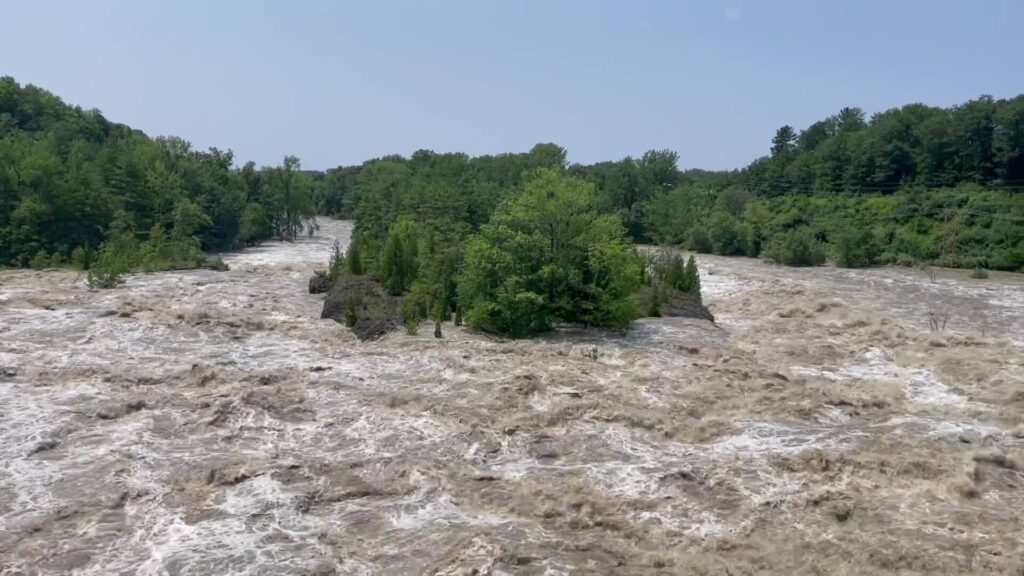As powerful floods swept through Vermont and Maine in 2023 and early 2024, they left communities struggling to cope and highlighted the increasing risks posed by climate change. Record rainfall caused rivers to surge, inundating towns, damaging infrastructure, crippling transportation networks, and forcing evacuations.
In Maine, the Kennebec River in Augusta reached 25 feet, eight feet above flood stage, submerging parts of the historic downtown. Similarly, the Androscoggin River in Rumford crested at 22 feet, flooding riverside communities, and causing widespread damage. In Newry, the Sunday River Ski Resort faced severe flood damage, taking out a portion of the entry road, impacting holiday season operations and jeopardizing winter tourism. And finally, unprecedented coastal flooding swept away a historic fishing shack at Willard Beach in South Portland, a stark visual of the impact of rising sea levels.
To the west, Vermont faced similar scenarios. In July 2023, the Winooski River overflowed its banks and caused flooding in the fields next to the state offices. Widespread power outages and road closures paralyzed parts of the state, hampering emergency response efforts. Some areas saw more than nine inches of rain, which significantly contributed to the flooding.

During the floods, Matthew Vaughan, NEIWPCC environmental analyst and chief scientist for the Lake Champlain Basin Program (LCBP), was on the scene, monitoring weather projections as he witnessed the historic rainfall and flooding throughout the watershed. Vaughan emphasized climate change’s role in altering rainfall patterns and increasing extreme weather events in Vermont and beyond.
Lake Champlain’s rivers are experiencing more winter rain, less spring snowmelt, and more frequent summer and fall storms due to climate change. These changes make flooding more likely, which adds more nutrients and pollution to the lake, negatively impacting water quality. Numerous mitigation projects helped lessen the impact in 2023, and underscore the need for further investment in areas still vulnerable.
“Many infrastructure investments made following the 2011 Tropical Storm Irene paid off in 2023; upgraded culverts and bridge crossings performed well under comparable high-flow conditions,” said Vaughan. “Areas without these upgrades were more susceptible to damage and will provide learning opportunities as we make long-term preparations for the next flood.”
Vaughan has taken his water quality insights on the road, speaking at several public events like the LCBP “Love the Lake” speaker series to raise awareness about the short- and long-term environmental impacts these extreme events can have.
In response to the major flooding, Vermont communities rallied with support and aid, drawing on lessons learned from Tropical Storm Irene which dumped approximately 3 to 7 inches of rain in just 24 hours. State and local governments-initiated recovery efforts, with emergency funding allocated to rebuild infrastructure.
Additionally, the LCBP offered Emergency Flood Relief Grants of up to $7,500 to non-profit organizations impacted by the disaster to assist with recovery efforts. The grants helped cover costs associated with building repairs, replacing office supplies and equipment, and supporting staff involved in flood response efforts.
Making the climate connection
Numerous scientific studies link the rise of extreme weather events, including intense rainfall and flooding, to our changing climate. This concern is echoed by the National Oceanic and Atmospheric Administration (NOAA) and state agencies, all of whom warn of an increased risk of flooding due to more frequent and intense storms, similar to those witnessed in 2023 and early 2024. According to the 2022 NOAA Sea Level Rise Technical Report, coastal flooding in the U.S. is expected to be five times more frequent by 2050 compared to current rates. Studies underscore the urgent need for long-term investments in flood mitigation strategies, infrastructure upgrades, climate-smart planning, and nature-based solutions such as wetland restoration.
The destructive floods in Maine and Vermont serve as a reminder of the challenges posed by a changing climate. While the recovery process may be long, these events present an opportunity to rebuild with resilience in mind. By investing in climate-smart infrastructure, embracing nature-based solutions, and fostering community-led planning, we can mitigate the impacts of future extreme weather events.
NEIWPCC plays a vital role in this regional effort. Through facilitating collaboration, sharing knowledge, and supporting projects focused on climate resilience, NEIWPCC helps build a more sustainable future for the Northeast.